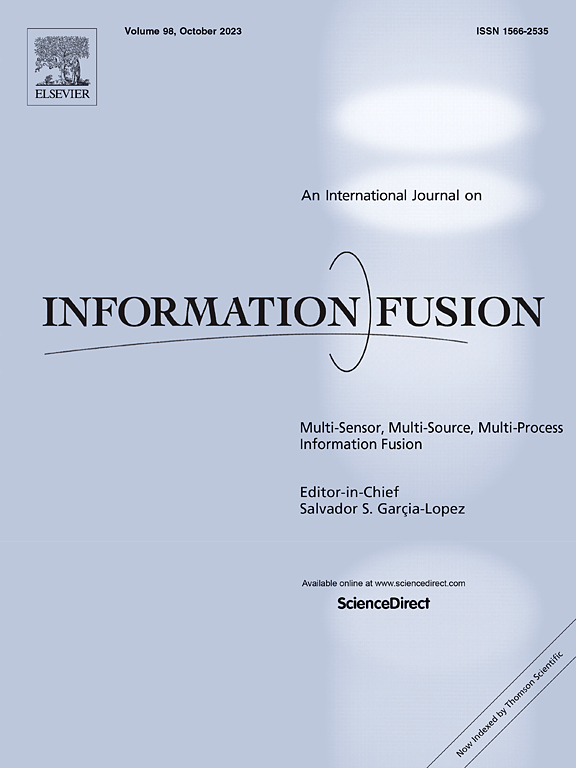融合注意诊断网络(FADNet):视盘分割和眼部疾病分类的端到端框架
IF 15.5
1区 计算机科学
Q1 COMPUTER SCIENCE, ARTIFICIAL INTELLIGENCE
引用次数: 0
摘要
数以亿计的人因病理性近视和其他眼部疾病而失明和严重视力受损,构成重大的全球公共卫生问题。这些疾病的准确诊断和及时治疗在很大程度上依赖于眼底图像中关键解剖结构(如视盘)的精确分割,这对于识别疾病类型和及时有效的临床干预至关重要。虽然医学图像分析取得了很大的进展,但现有的方法往往将分割和分类作为单独的任务,导致性能有限,临床适用性差。在这项工作中,我们提出了一个创新的端到端框架,称为融合注意诊断网络(FADNet),它统一了眼部疾病分类和视盘分割任务。FADNet的核心创新点在于动态加权特征融合策略,利用上下文感知的加权机制,将分割蒙版无缝融合到眼底原始图像中。这种方法放大了病理区域的贡献,增强了随后分类的特征相关性。该框架首先使用注意力U-Net实现精确的视盘分割,然后使用基于resnet的分类网络从融合后的图像中诊断眼部疾病。在icchallenge - pm和Retina数据集上的实验表明,FADNet达到了最先进的性能,在二元分类中达到97.1%,在多类分类中达到90.4%,超过了现有的方法。FADNet采用联合优化策略,提高了分割和分类任务之间的协同性,显著提高了诊断的准确性和鲁棒性。FADNet展示了其在多个数据集上的有效性和适应性,为眼科疾病的自动诊断提供了全面实用的解决方案,未来在临床环境中具有巨大的应用潜力。本文章由计算机程序翻译,如有差异,请以英文原文为准。
Fusion-Attention Diagnosis Network (FADNet): An end-to-end framework for optic disc segmentation and ocular disease classification
Hundreds of millions of people suffer from blindness and severe vision impairment due to pathologic myopia and other ocular illnesses, posing substantial worldwide public health issues. Accurate diagnosis and timely treatment of these conditions heavily rely on the precise segmentation of key anatomical structures in fundus images, such as the optic disc, which is essential for identifying disease types for timely and effective clinical interventions. Although medical image analysis has made significant progress, existing methods often address segmentation and classification as separate tasks, resulting in limited performance and poor clinical applicability. In this work, we present an innovative end-to-end framework named Fusion-Attention Diagnosis Network (FADNet), which unifies ocular disease classification and optic disc segmentation tasks. The core innovation of FADNet lies in the Dynamic Weighted Feature Fusion strategy, which seamlessly integrates the segmentation mask into the original fundus image using a context-aware weighting mechanism. This approach amplifies the contribution of pathological regions, enhancing feature relevance for subsequent classification. The framework first employs an Attention U-Net to achieve accurate optic disc segmentation, followed by a ResNet-based classification network to diagnose ocular diseases from the fused image. Experiments on the iChallenge-PM and Retina datasets indicate that FADNet attains state-of-the-art performance, achieving accuracies of 97.1% in binary classification and 90.4% in multi-class classification, surpassing current methodologies. FADNet outperforms previous methods by its joint optimization strategy, which improves the synergy between segmentation and classification tasks, resulting in notable improvements in diagnostic accuracy and robustness. FADNet showcases its effectiveness and adaptability across multiple datasets, offering a comprehensive and practical solution for the automated diagnosis of ocular diseases, with significant potential for future deployment in clinical settings.
求助全文
通过发布文献求助,成功后即可免费获取论文全文。
去求助
来源期刊

Information Fusion
工程技术-计算机:理论方法
CiteScore
33.20
自引率
4.30%
发文量
161
审稿时长
7.9 months
期刊介绍:
Information Fusion serves as a central platform for showcasing advancements in multi-sensor, multi-source, multi-process information fusion, fostering collaboration among diverse disciplines driving its progress. It is the leading outlet for sharing research and development in this field, focusing on architectures, algorithms, and applications. Papers dealing with fundamental theoretical analyses as well as those demonstrating their application to real-world problems will be welcome.
 求助内容:
求助内容: 应助结果提醒方式:
应助结果提醒方式:


